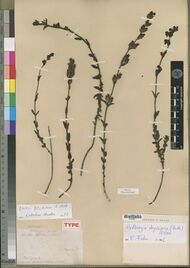Biology:Hedbergia
| Hedbergia | |
|---|---|

| |
| Holotype of Hedbergia abyssinica (herbarium specimen). | |
| Scientific classification | |
| Kingdom: | Plantae |
| Clade: | Tracheophytes |
| Clade: | Angiosperms |
| Clade: | Eudicots |
| Clade: | Asterids |
| Order: | Lamiales |
| Family: | Orobanchaceae |
| Tribe: | Rhinantheae |
| Genus: | Hedbergia L. |
| Species: | H. abyssinica
|
| Binomial name | |
| Hedbergia abyssinica (Benth.) Molau
| |
| Synonyms[1] | |
| |
Hedbergia is a monotypic genus of flowering plants, initially classified in Scrophulariaceae, and now within the broomrape family Orobanchaceae.[2] It contains a unique species, Hedbergia abyssinica.[1] It is an afromontane genus, widespread in grasslands and scrubs of the mountains of tropical Africa, and known from Ethiopia, Zaire, Uganda, Kenya, Tanzania, Malawi, Nigeria, and Cameroons.[2]
The genus name is a taxonomic patronym honoring the Swedish botanist Karl Olov Hedberg.
Description
Hedbergia abyssinica is a 1–2.5 feet (30–76 cm) high, very hispid perennial plant, with subsessile thick leaves, and densely crowded, white to pink or magenta flowers.[3][2]
Phylogeny
The phylogeny of the genera of Rhinantheae has been explored using molecular characters.[4][5] Hedbergia belongs to the core Rhinantheae. Hedbergia is closely related to Odontites, Bellardia, and Tozzia. In turn, these genera share phylogenetic affinities with Euphrasia, and then with Bartsia.
| Genus-level cladogram of tribe Rhinantheae. |
| The cladogram has been reconstructed from nuclear and plastid DNA molecular characters (ITS, rps16 intron and trnK region).[4][5] |
References
- ↑ 1.0 1.1 "Hedbergia abyssinica (Benth.) Molau – The Plant List". http://www.theplantlist.org/tpl1.1/record/kew-2840776.
- ↑ 2.0 2.1 2.2 Molau, Ulf (1988). "Hedbergia, a new genus of Scrophulariaceae from Africa" (in en). Nordic Journal of Botany 8 (2): 193–195. doi:10.1111/j.1756-1051.1988.tb00500.x. ISSN 1756-1051.
- ↑ "BARTSIA abyssinica Hochst. ex Benth. [family SCROPHULARIACEAE"]. Global Plants. JSTOR. https://plants.jstor.org/stable/10.5555/al.ap.flora.flota007436.
- ↑ 4.0 4.1 Těšitel, Jakub; Říha, Pavel; Svobodová, Šárka; Malinová, Tamara; Štech, Milan (2010-10-28). "Phylogeny, Life History Evolution and Biogeography of the Rhinanthoid Orobanchaceae" (in en). Folia Geobotanica 45 (4): 347–367. doi:10.1007/s12224-010-9089-y. ISSN 1211-9520.
- ↑ 5.0 5.1 Scheunert, Agnes; Fleischmann, Andreas; Olano-Marín, Catalina; Bräuchler, Christian; Heubl, Günther (2012-12-14). "Phylogeny of tribe Rhinantheae (Orobanchaceae) with a focus on biogeography, cytology and re-examination of generic concepts". Taxon 61 (6): 1269–1285. doi:10.1002/tax.616008.
Wikidata ☰ {{{from}}} entry
 |

